Connected Driving
Connected Driving - Glazing Developments
It is not too long ago that the concept of 'being connected' when driving would consist either of the blast of a horn, a flash of the headlights or the pulse of side indicator lights. These connections would only be by audible or visual means - with the role of glazing being relatively limited. As mobile communications, data processing and display systems rapidly evolve, the driving experience is increasingly being connected to both the local and global environment, with glazing becoming a natural medium and platform for this evolution. As such, the selected items below provide an overview from a glazing perspective of being increasingly connected in the automotive world.
- Glazing with integrated antenna
- Advanced Driver Assistance Systems (ADAS)
- Advanced Driver Assistance Systems (ADAS) - glazing replacement
- Head Up Display
- Outlook
Glazing with integrated antenna
With the rapid evolution of electronic communication, different parts of the electromagnetic spectrum continue to be developed and utilised. Besides its natural visible transmission, glass is also transparent to the frequencies for radio wave type communication. This electronic compatibility of glazing was first utilised by NSG antenna engineers as far back as 1970, when AM/FM was designed into windscreens in Japan. The desire to build more systems seamlessly into the vehicle as technology advanced has led to analogue TV, telephone, XM satellite radio, digital TV and DAB being designed in or on to glazings. NSG has antenna design capability and facilities in Japan and Germany to service and compliment future customer requirements.
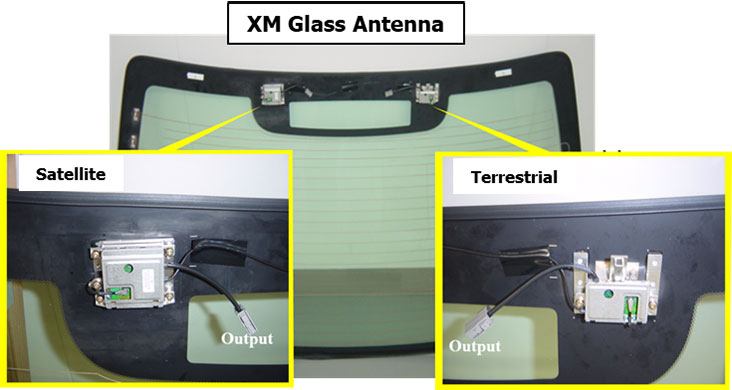
Example of an on-glass antenna designed for a rear vehicle window
As the number of electronic applications is increasing rapidly inside a vehicle, the compatibility of integration becomes ever more complex, therefore computer simulation development techniques are increasingly utilised to improve the antenna glass signal performance.
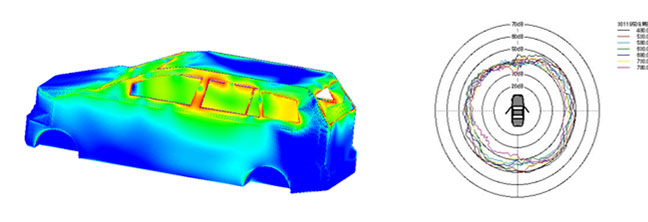
Computer simulation example to aid antenna performance design
Advanced Driver Assistance Systems
The future developments of on-glass antenna systems for Vehicle-to-everything (V2X) wireless sensors and Vehicle-to-Network (V2N) 5G antennae will support the evolution of Advanced Driver Assistance Systems (ADAS). Connectivity between vehicles and their surroundings is primarily aimed at avoiding crashes, and developments in this field are being underpinned by legislation around the world. Increasing combinations of precise positioning, radar (long range, low light scenarios), cameras (to interpret objects), Lidar (medium range assessment) and ultrasonics (short range) coupled with increased computational power will enable the maturity of ADAS.
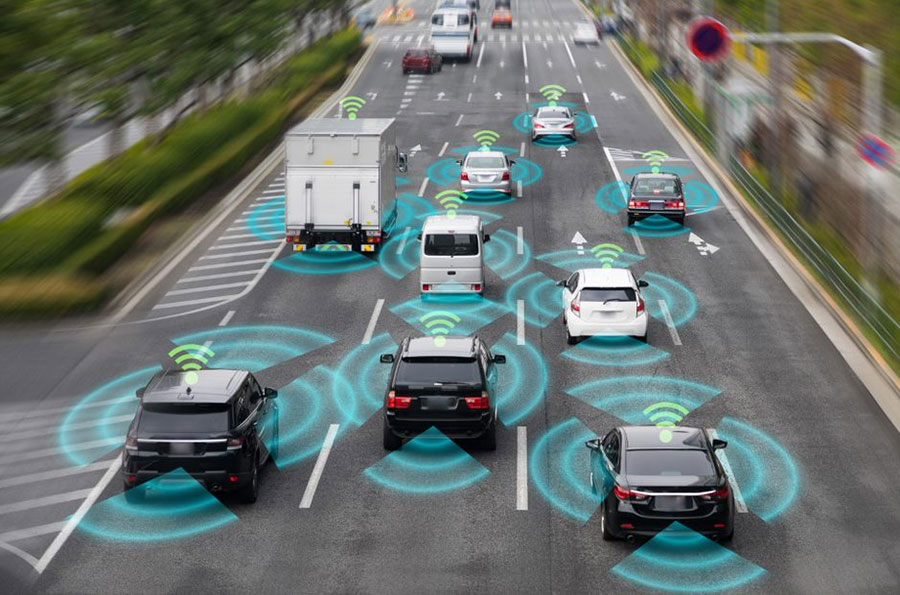
Illustration of ADAS vehicle to vehicle communications to improve safety
As these safety systems inside vehicles evolve to higher levels of assisted driving functions, glazing increasingly plays a key role due to its transparency at the key frequencies for operation. Features such as lane keep assistance, intelligent speed assistance and object recognition can be provided by camera systems mounted to the windscreen, which provides an optimal field of view, and is the ideal location choice. Lidar (light detection and ranging) systems operate with very high glazing transparency, in particular in the near-infrared range. To enable this feature, NSG has utilised its capabilities to design and manufacture coatings to allow increased levels of transmission that provide optimised Lidar performance.
In addition, the camera field of view can be kept clean by the existing wash/wipe system, and be de-iced/de-misted by specially designed heating elements on, or in, the glazing. NSG works in close development cooperation with vehicle manufacturers in the design of the camera mounting to the windscreen, the optimisation of the optical transmission zone for the camera, the local heating of the camera and to finally inspect the system to ensure it meets the requirements for operation. The vehicle manufacturer calibrates the camera system for operation once installed onto the windscreen as part of diagnostic checks (to synchronise and align the system).
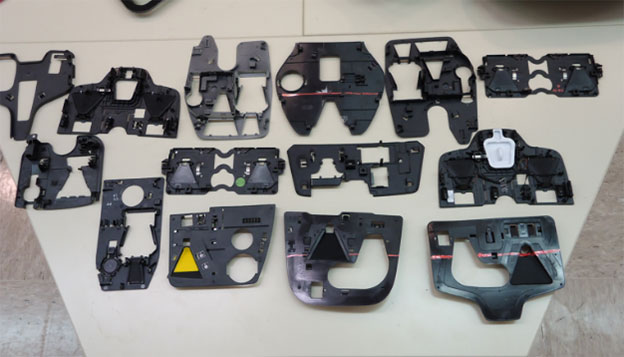
Types of brackets (for camera and sensors) that are bonded to the windscreen by NSG
Advanced Driver Assistance Systems - glazing replacement
Windscreen mounted camera and safety systems not only have to function correctly when a vehicle leaves the showroom, but they also have to maintain the same high standards when windscreens have to be replaced after stone damage. Here the first challenge has been to highlight to the consumer and glass replacement specialists the importance of a premium Quality replacement windscreen combined with thorough replacement techniques and calibration.
For windscreen replacement away from service centres, NSG, with partners, can provide in-vehicle calibration of the camera systems to minimise inconvenience to the motorist. In the past, replacing a windscreen was just a matter of swapping a broken glass with a brand-new NSG product. With the introduction of ADAS systems, that has changed. Nowadays cars need to "see", "hear" and "feel" the environment through a series of sensors. Many of those sensors are installed directly onto the windscreen. Poor glass construction or incorrect installation may result in this critical safety systems inability to function as intended.
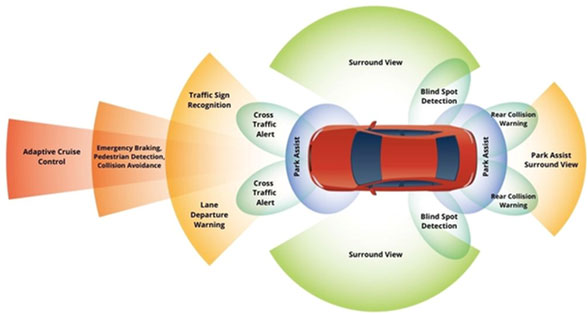
Illustration of available ADAS systems
If the car "thinks" a lane is 1m away when it's not, the Lane Departure Warning will not work properly, either constantly pushing the vehicle towards the centre of the road or allowing the car to run over the lane. Even more seriously, if the car "thinks" the vehicle ahead is further than it really is, the emergency braking system might engage later than intended. In addition to supplying top quality glass, NSG also pioneered the use of a tool that aligns what the vehicle “sees” with reality.
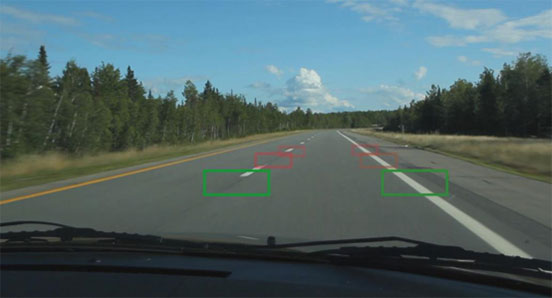
ADAS calibration example for Lane Departure Warning
NSG, through the Pilkington North America brand, proudly provides a complete solution with both tools and the service to our glass replacement customers. Meanwhile NSG in Europe is launching its Remote Calibration Overair (ReCO) service that completes specialist calibrations for customers wherever they are.
NSG ADAS solution provider partners for the North American replacement glazing market
Head Up Display
A further connected driving technology that continues to evolve is the use of Head Up Display (HUD). The projected virtual image that the driver sees has traditionally been around 2m out from the windscreen. As the projected image system uses light reflections, the windscreen shape needs to be very closely controlled to prevent local optical distortions. Additionally, a specially designed polyvinyl butyral (PVB) interlayer is utilised to maximise image sharpness. NSG has recently moved to series production with new systems that use Augmented Reality HUD. With this technology, the moving virtual images extend 8 metres and beyond, providing a dynamic display driving enhancement. This advanced display works in harmony with NSG's Advanced Press Bending windscreen technology.

Illustrations of Head Up Display operation
Outlook
As we move to an increasingly automated age, the role of glazing will continue to redefine itself. Besides the original need of glazing to keep the wind and rain out, its visual and optic transparency, its display reflectivity, and its compatibility with many forms of electromagnetic communication system will continue to provide solutions for the digital engineers of the future. It will also mean that to be connected in the future will see 'the flash of headlights' and 'the blast of the horn' eventually consigned to the history books.
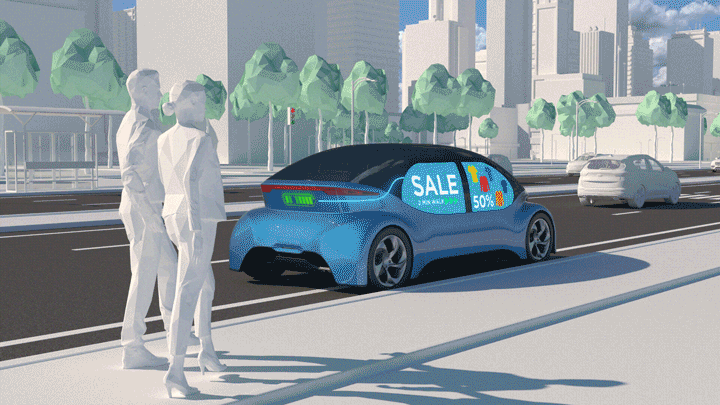
Visualisation of a future vehicle connecting to its environment